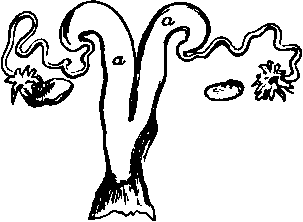203. The Uterus Or Womb
Description
This section is from the book "Animal Physiology: The Structure And Functions Of The Human Body", by John Cleland. Also available from Amazon: Animal Physiology, the Structure and Functions of the Human Body.
203. The Uterus Or Womb
The Uterus Or Womb is a muscular organ placed, in ordinary circumstances, within the pelvis. It is a pear-shaped body about three inches long, flattened from before backwards, and connected with the abdominal wall in each groin by means of a round ligament. When clipped open it is seen to have exceedingly strong walls; its lower portion, the cervix, extending for about an inch upwards from the mouth or inferior opening (os externum), surrounds a separate cavity with rugose mucous membrane, divided by a constriction (os internum) from the smoothly-lined main cavity, destined for the reception and development of the ovum. This main cavity, contained within the body or fundus of the uterus, although destined to undergo enormous temporary enlarge-axent in pregnancy, is of small size at other times, with its anterior and posterior walls in contact, and its three borders, one above and one at each side, all bulging inwards. The upper angles are distinguished as the cornua, being parts which in many of the lower animals are greatly elongated, so as to render the uterus completely forked. Into each cornu opens a long narrow duct, the Fallopian tube, which extends outwards in front of the ovary, and terminates immediately beyond it in an expanded and fringed opening, the fimbriated extremity, which leads from the peritoneal cavity, and makes a communication between it and the outside of the body. In animals in which the cornua are developed, they are the parts which lodge the young. Thus, in a sheep with one lamb, the lamb occupies one cornu; if there be twin lambs, they lie one in each cornu; and in animals which have a litter of young, the embryos are ranged in series in separate membranes along the length of each cornu.

Fig. 142. Uterus of Sheep. a, a, The cornua.
Continue to:
- prev: 202. The Ovum Or Egg
- Table of Contents
- next: 204. The Ovaries Of Persons Who Have Died In The Prime Of Life Present
